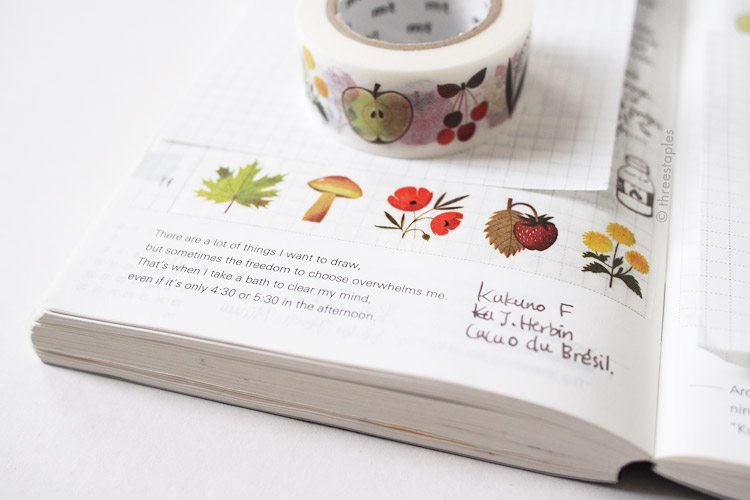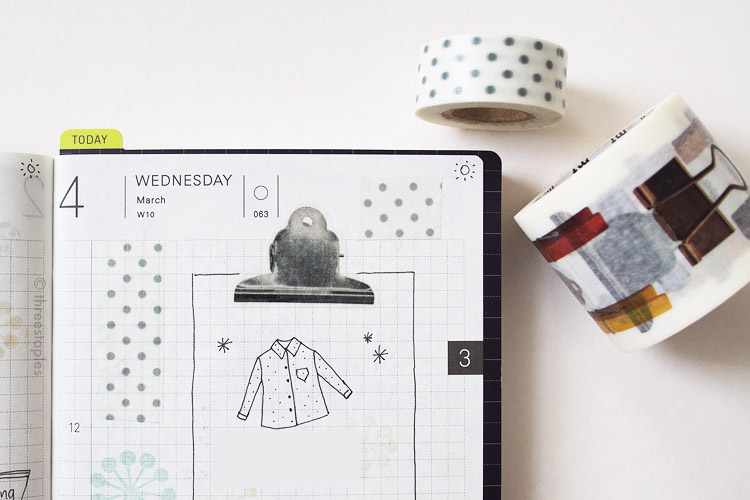This is the second of a small series of posts where I'll share what I've learned about Hobonichi and its Tomoe River paper. You can read the first post here, on rubber stamping.
Sometimes I like to decorate my Hobonichi with washi tapes. Not only are they visually interesting, they can be used as space dividers when I want different sections on the page. They also help me overcome the fear of writing on an empty page. And sometimes it's a quick way to illustrate what I'm writing, if the tape's design matches the topic. So all around, good tools to have for a little fun in journaling.
It was a rainy day, a perfect excuse to bust this tape out.
Sometimes, I decorate Hobonichi pages like this even before writing. It actually motivates me to write!
Some of my mizutama tapes in action. No, I don't think I was writing about undies. It just cracks me up.
But, what I’ve discovered is that washi tapes adhere to the Tomoe River paper much more strongly than they do to “regular” papers. I learned it the hard way when I tried to peel a piece of washi tape off and ended up damaging the paper (washi tapes are known to be re-positionable). You'd think that the TR's smooth surface would make it easier to peel... but nope. I'm sure it depends on each tape's adhesive but now I try position the tape perfectly the first time around. If I mess up, I try to leave it alone. Plus, the Tomoe River paper is so thin that even when the tape is peeled off successfully, it ends up warping or stretching the paper. So, better be safe than sorry!
Grid definitely helps when aligning colored tapes like this.
Another thing I learned: it’s better to cut tapes with a pair of scissors, so that the resulting edge is very clean. I know that one of the benefits of washi tapes is that they can be cut easily with your fingers. But that leads to an irregular, sometimes sticky edge that can stick to the opposing page in Hobonichi. That's a bit annoying, and potentially damaging.
I cut these tapes with the cutter they were packaged with and now they stick to the opposite page.
This isn't something inherent about the Tomoe River paper or washi tapes but more of a preference I developed after using Hobonichi for the past year or so. I learned that I like washi tape designs that have “clear backgrounds” because they're more versatile and forgiving in page layouts. I’m talking about tapes that are semi-transparent white or off-white with designs that are not edge-to-edge. They don’t have harsh edges that require me to be more careful in aligning (although the grid in Hobonichi helps), which leads to less reasons to re-position the tape. I can cut them into little pieces and have them "float" in middle of the page. And they can look integrated with my writing and drawings more easily than the tapes with colored backgrounds. I still buy tapes that have colored backgrounds (and they have their own uses) but not as much. I certainly never thought I would use the tapes with clear backgrounds this much!
Tapes with colored backgrounds (left stack) vs. tapes with “clear” backgrounds (right stack).
Some tapes, I cut around the design, instead of a simple rectangle, so I have more writing space around it.
Overlapping tapes can be a whole different game, with fun results. Another reason why I prefer “clear” tapes.
I really like tapes with black & white or gray designs, too, because they allow me to mix and match easily for a more harmonious look. Before Hobonichi, I would have never thought I would prefer plain B&W tapes but now I do!
Thinner tapes like these can act as really good space dividers on journal pages. The tape cutter is a fantastic one from Muji; I loaded it with two separate rolls.
Are you a fan of washi tapes like I am? Do you find the Tomoe River paper in Hobonichi to be stickier, too, or am I alone in this?
Related links:
- Check out Natsume on Instagram, at natsume_notebook. She is a master at Hobonichi page layouts using a limited color palette.
- See how the talented April at Penguins Creative mixes washi tapes and drawings in her Hobonichi, at her Instagram penguinscreative.
- Other inspiring Hobonichi users at Instagram: __freenote and linenworks.

















